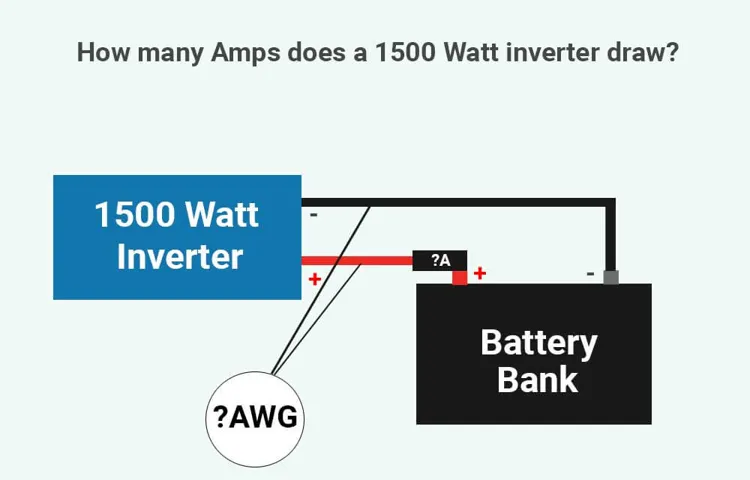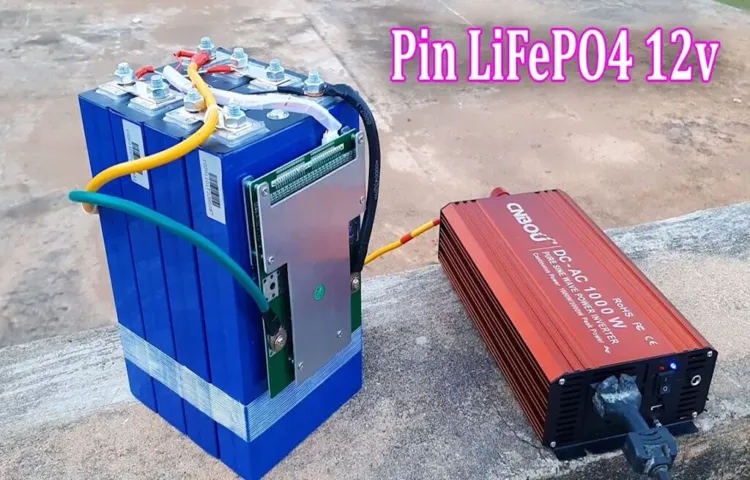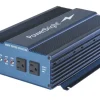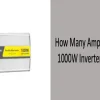Have you ever wondered how many amps a 12-volt inverter needs to function properly? Well, you’re not alone. Many people find themselves confused when it comes to understanding the power requirements of an inverter. After all, inverters are essential for powering various devices and appliances while on the go, such as laptops, smartphones, and even mini-fridges.
But what exactly does it take to ensure that your inverter operates efficiently without causing any damage? In this blog post, we will break down the ins and outs of inverter power requirements and shed some light on how many amps a 12-volt inverter needs. So, let’s dive in and unravel the mystery together!
Table of Contents
Understanding 12 Volt Inverters
If you’re wondering how many amps a 12-volt inverter needs, the answer can vary depending on the specific inverter and its intended use. Inverters are devices that convert DC power from a battery into AC power, allowing you to power appliances and electronics that typically run on AC power. The number of amps needed by a 12-volt inverter will depend on the power requirements of the devices you want to run.
Different appliances and electronics have different power ratings, measured in watts. To determine the number of amps your inverter needs, you’ll need to divide the total wattage of the devices you want to power by 12 volts. For example, if you have a total load of 600 watts, you would divide that by 12 volts to get 50 amps.
It’s important to choose an inverter with a capacity that can handle your power needs to ensure safe and efficient operation.
What is a 12 Volt Inverter?
12 volt inverters are devices that convert direct current (DC) power from a 12-volt battery into alternating current (AC) power that can be used to power household appliances and electronic devices. These inverters are essential for use in vehicles, such as cars, recreational vehicles (RVs), and boats, as well as for off-grid solar power systems. Imagine you’re on a road trip in your RV and want to power your laptop or charge your phone.
Without a 12 volt inverter, you would have to rely on finding a power source at a campground or use up your device’s battery. However, with a 12 volt inverter, you can easily plug in your devices and enjoy the convenience of having power wherever you go. These inverters come in different sizes and capacities, ranging from small inverters that can power a single device to larger ones that can power multiple appliances simultaneously.
They typically have multiple outlets or USB ports, allowing you to connect various devices at the same time. One key aspect to consider when choosing a 12 volt inverter is its power rating. This indicates the maximum amount of power it can supply.
It’s important to ensure that the inverter you choose has a sufficient power rating to meet the demands of your devices. For example, if you plan to power a laptop, a phone charger, and a mini refrigerator, you would need an inverter with a higher power rating compared to someone who only needs to power a laptop. Another important factor to consider is the inverter’s waveform.
Most modern 12 volt inverters provide a modified sine wave, which is suitable for powering most household appliances and electronic devices. However, if you have sensitive equipment that requires a pure sine wave, you would need to invest in a higher-end inverter that provides this type of waveform. In conclusion, a 12 volt inverter is a versatile and essential device for anyone who wants to power their appliances and electronic devices while on the go or in an off-grid setting.
It allows for convenience and flexibility, making it easier to enjoy the comforts of home even when you’re away. So, whether you’re planning a camping trip or equipping your RV for a road adventure, a 12 volt inverter is a must-have to ensure that you have power whenever and wherever you need it.

How Does a 12 Volt Inverter Work?
12 volt inverter
Determining the Amps Required
If you’re wondering how many amps a 12-volt inverter needs, it all depends on the power requirements of the devices you plan to use with it. Inverters convert the 12-volt DC power from your battery into 110-volt AC power, allowing you to power appliances and electronics that require standard household voltage. To determine the amps required for your inverter, you’ll need to know the wattage of the devices you want to use and divide that by 12 (since it’s a 12-volt inverter).
For example, if you want to power a device that requires 120 watts, you would divide 120 by 12 to get 10 amps. It’s always a good idea to choose an inverter with a little extra capacity to account for potential power surges or spikes.
Calculating Power Consumption
power consumption, amps required. Determining the amps required to power a device is an important step in calculating power consumption. Amps, or amperes, are a unit of electrical current measurement that determines how much electric charge flows through a circuit per second.
To determine the amps required for a device, you need to know the voltage and power rating of the device. The power rating is often provided on the device or in the product manual and is measured in watts. To calculate the amps, you can use Ohm’s Law, which states that the current flowing through a circuit is equal to the voltage divided by the resistance.
In this case, the resistance can be calculated by dividing the power rating by the voltage. For example, if you have a device with a power rating of 100 watts and it operates on a voltage of 120 volts, you can calculate the resistance by dividing 100 by 120. This gives you a resistance of 0.
83 ohms. Once you have the resistance, you can use Ohm’s Law again to calculate the amps. Just divide the voltage by the resistance.
Using our example, the calculation would be 120 divided by 0.83, which gives us approximately 144 amps. It’s important to note that this calculation is theoretical and assumes the device operates at its maximum power rating.
In reality, the actual power consumption may vary depending on factors such as efficiency and load. It’s always a good idea to consult the device specifications or consult with an expert if you need an accurate measurement of power consumption for a specific device. By determining the amps required for a device, you can better understand its power consumption and make informed decisions about electrical usage and efficiency.
Considering Efficiency
Determining the Amps Required When it comes to electrical efficiency, knowing the amps required for your devices is crucial. Amps measure the amount of current flowing through a circuit, and by determining the amps required, you can ensure that your electrical system can handle the load without overloading or tripping circuit breakers. So how do you determine the amps required? Well, it’s actually quite simple.
First, you need to identify the wattage of the device you want to connect to the circuit. The wattage is usually listed on the device itself or in the product manual. Once you have the wattage, you can calculate the amps required using the formula: Amps = Watts / Volts Let’s say you have a device with a wattage of 1000 and you are using a standard 120-volt electrical outlet.
By plugging these numbers into the formula, you can determine that the device requires approximately 33 amps. It’s important to note that this calculation is based on the assumption that the device operates at full power.
This means that if the device has a variable power setting or operates at different levels, you may need to adjust the calculation accordingly. Additionally, it’s always a good idea to leave some room for flexibility in your electrical system. Overloading circuits can lead to electrical fires or damage to your devices, so it’s best to err on the side of caution and use a lower amperage rating if you’re unsure.
By understanding and calculating the amps required for your devices, you can ensure that your electrical system operates efficiently and safely. So the next time you’re connecting a new device, don’t forget to consider the amps!
Choosing the Right Inverter
When choosing the right inverter for your needs, one important factor to consider is how many amps it needs. In the case of a 12-volt inverter, the amp requirement will depend on the specific electrical devices you plan to power. Each device will have a different power draw, usually measured in watts.
To determine the amps needed, you can use the formula: amps = watts / volts. For example, if you have a device that requires 120 watts of power, you would divide that by 12 volts to get a result of 10 amps. This means you would need an inverter that can handle at least 10 amps.
Keep in mind that it’s always a good idea to have some extra capacity, so it’s recommended to choose an inverter with a higher amp rating to accommodate any additional devices or future needs.
Matching Amps to Device Requirements
inverter, device, amp, requirements, choosing
Taking into Account Surge Power
When it comes to choosing the right inverter for your power needs, it’s important to take into account surge power. Surge power refers to the additional power required when certain appliances or devices start up, such as refrigerators or air conditioners. If you don’t consider surge power when selecting an inverter, it could lead to insufficient power supply and potential damage to your devices.
To ensure you choose the right inverter, look for one that has a surge power rating that matches or exceeds the surge power of the appliances you plan to connect to it. This way, you can be confident that your inverter can handle the initial power surge and continue to supply sufficient power for all your needs.
Conclusion
So, how many amps does a 12 volt inverter need? Well, it’s not just about the amps, my friend. You see, a 12 volt inverter is like a magician, taking the humble 12 volts and transforming it into the mesmerizing world of AC power. And just like a magician needs his energy to perform his tricks, so does the inverter.
But here’s the thing, it’s not all about the amps. Sure, they play a role in determining the power output of the inverter, but it’s also about the efficiency of the inverter itself. You see, just like a sly fox, the inverter wants to make the most out of its 12 volts.
It wants to convert as much of that humble DC power into AC power without wasting any precious energy. So, how many amps does it need? Well, it depends on what you want to power with the inverter. Different devices have different power requirements, and it’s up to the inverter to provide that power.
Think of it like a buffet – some devices may only need a small appetizer of power, while others may want to indulge in a full-course meal. But fear not, my curious friend, for there is a simple formula to guide you on your quest for the right amount of amps. It’s called Watt’s Law, and it goes a little something like this: power (in watts) equals voltage (in volts) times current (in amps).
Now, armed with this knowledge, you can calculate the amps needed for your inverter based on the power requirements of your desired device. So go forth, my friend, and let the amps flow through the magical realm of the 12 volt inverter, powering your devices with efficiency and with a touch of enchantment.”
FAQs
How many amps does a 12 volt inverter need?
The number of amps a 12 volt inverter needs depends on the specific electrical devices you plan to power. To calculate the amps required, you can divide the wattage of the devices by 12 volts. For example, a 1200 watt device would need 100 amps (1200 watts ÷ 12 volts = 100 amps).
What factors should I consider when determining the amp requirement for a 12 volt inverter?
When determining the amp requirement for a 12 volt inverter, you should consider the wattage of the devices you plan to power, the duration of usage, any additional power needs (such as starting currents or surge loads), and any safety margins you want to include.
Can I use a higher amp rated inverter with a 12 volt battery?
Yes, you can use a higher amp rated inverter with a 12 volt battery. In fact, it is often recommended to have some extra capacity to handle surges or unexpected power needs. However, make sure that your battery can provide enough power to meet the higher amp rating.
Are there any safety precautions I should take when using a high amp rated inverter with a 12 volt battery?
Yes, when using a high amp rated inverter with a 12 volt battery, it is important to ensure that your battery and electrical system can handle the increased current. You should also use appropriate gauge wiring to minimize voltage drop and potential overheating. Additionally, it is important to follow manufacturer instructions and safety guidelines to prevent any electrical hazards.
What is the efficiency of a 12 volt inverter?
The efficiency of a 12 volt inverter refers to how effectively it converts DC power from a battery to AC power for your devices. Inverters typically have an efficiency rating, expressed as a percentage, that indicates the amount of power lost during the conversion process. Higher efficiency inverters are better as they waste less energy.
Can I run multiple devices simultaneously with a 12 volt inverter?
Yes, you can run multiple devices simultaneously with a 12 volt inverter, as long as their combined amp draw does not exceed the inverter’s amp rating. It is important to check the power requirements of all devices to ensure they can be safely powered by the inverter.
How can I extend the battery life of a 12 volt inverter?
To extend the battery life of a 12 volt inverter, you can use energy-efficient devices, minimize the duration of usage, and avoid overloading the inverter. It is also important to properly maintain and charge the battery to ensure its longevity.
Can a 12 volt inverter be used in a vehicle? A8. Yes, a 12 volt inverter can be used in a vehicle to power various electrical devices. However, it is important to check the vehicle’s electrical system capacity and fuse ratings to ensure they can handle the inverter’s power output. It is also important to connect the inverter directly to the battery using appropriate wiring and safety precautions.



